Radhanagari Wildlife Sanctuary
Radhanagari Wildlife Sanctuary (Marathi: राधानगरी वन्यजीव अभयारण्य) is a wildlife sanctuary and natural World Heritage Site of category ix and x since 2012, located in Kolhapur district, Maharashtra State, India. It lies at the southern end of the Sahyadri hills in the Western Ghats. It is notable as the first declared wildlife sanctuary in Maharashtra, notified in 1958, as "Dajipur Wildlife Sanctuary" and is popularly known as the "Bison Sanctuary".[1] Indian bison or gaur (Bos gaurus) with a population around 1091 in 2014, is the flagship species of the area. It was notified as Radhanagari wildlife sanctuary vide notification No. WLP/1085/CR/588/ V/F-5,Dt.16.9.1985.[2]
| Radhanagari Wildlife Sanctuary | |
|---|---|
| राधानगरी अभयारण्य | |
IUCN category IV (habitat/species management area) | |
 | |
| Location | Kolhapur district, Maharashtra, India |
| Nearest city | Kolhapur 46 kilometres (29 mi) NE |
| Coordinates | 16°23.09′0″N 73°57.32′0″E |
| Area | 351.16 square kilometres (135.58 sq mi) |
| Established | 1958 |
| Governing body | Maharashtra Forest Department |
| World Heritage site | Since 2012 |
| Official name | Natural Properties - Western Ghats (India) |
| Type | Natural |
| Criteria | ix, x |
| Designated | 2012 (36th session) |
| Reference no. | 1342 |
| State Party | India |
| Region | Indian subcontinent |
Geography
This is a natural World Heritage Site notified by UNESCO as Sahyadri sub cluster of Western Ghats. The sanctuary is located between 16°10" to 16°30" north latitude and 73°52" to 74°14" east longitude. The Krishna River tributaries, Bhogavati River, Dudhganga River, Tulshi River, Kallamma River and Dirba River flow through the sanctuary's area.[1] State Highway 116 passes through the center of the sanctuary. It is located in Sahyadri hill ranges. The total area of the sanctuary is 351 km2 (136 sq mi).
Flora
Radhanagari Wildlife Sanctuary contains tropical evergreen forests typical of the northern Western Ghats.[1] 425 species of plants have been recorded in the sanctuary. The main species found over here are Anjani, Jambul, Hirda, Awala, Pisa, Ain, Kinjal, Amba, Kumbha, Bhoma, Chandala, Katak, Nana, Umbar, Jambha, Gela, Bibba and banana. Karvi is found over almost the entire area. Climbing plants such as shikekai and garambi are common. Shrub species and medicinal plants such as karvand, vagati (candy corn plant), ranmiri (orange climber), Tamalpatra Cinnamomum tamala, (toran), dhayati (fire-flame bush), kadipatta (curry tree), narkya, murudsheng (Indian screw-fruit) and a small amount of bamboo are also found. Large numbers of ephemeral bulbs of seasonal plants are also found here.[3] Many sacred groves or devrais have been protected as a result of the efforts of the local communities.[4]
- Flowers of Karvand bush
 Anjani flowers
Anjani flowers
Fauna
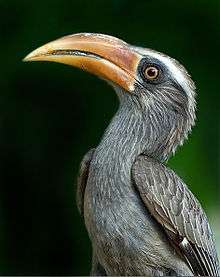
Sanctuary contains 47 species of Mammals, 59 species of reptiles, 264 species of birds and 66 species of butterflies. Amphibians are most visible in the rainy season. 20 species from 2 orders, 5 families and 10 genera are listed in the sanctuary.[5] Indian bison or gaur have a population around 610 in 2004,[4] is the flagship species of the area. Other mammals, living in the sanctuary are Indian leopard (5), sloth bear, wild boar (80), barking deer (140), mouse deer (80), sambar (120), giant squirrel 50) and wild dogs (70). In recent years, 6 to 12 tigers were reported in Dajipur forest 2007-08. (anonymous reports- not yet confirmed)
Birds seen here include: vultures, eagles, jungle fowl, quails, plovers, sandpipers, owlets, doves, owls, nightjars, kingfishers, bee-eater, hornbills, woodpeckers, bulbul, flycatchers, warblers, wagtails, sunbirds are commonly seen.[3] This sanctuary is designated as an Important Bird Area by BirdLife International and is home to the rare and globally threatened Nilgiri wood-pigeon (Columba elphinstonii). Other species found here include the Ceylon frogmouth, yellow-browed bulbul, dusky eagle-owl and great pied hornbill and one of India's most admired songbirds, the Malabar whistlingthrush. Two species endemic to the Western Ghats: the small sunbird and the Malabar grey hornbill have been sighted here. This sanctuary is a favorite nesting place for the speckled piculet, Malabar crested lark, and some species of Himalayan birds such as the Indian blue robin during the winter months.
Threatened species of reptiles and amphibians seen in this sanctuary include: Malabar pit viper, Deccan ground gecko, Gunther's cat skink, Beddome's lacerta, Bombay bush frog and Humayun's wrinkled frog.[4]
Threats
Open cast bauxite mining has been a serious threat to this protected area. In February 1998, the Bombay High Court passed a stay order halting bauxite mining operations in the Iderganj plateau. Other threats include, irrigation projects, encroachment of forest land, poaching, overgrazing, agriculture and construction of reservoirs.[4]
Visitor information
The nearest rail station is at Kolhapur, 45 km (28 mi). For accommodations, there is a forest rest house, dak bungalow, and a dormitory managed by the Deputy Conservator of Forests - Wildlife, Bindu chowk, Ganji Galli, Kolhapur. 416 002 India (91-231-2542766). There are two rest houses for the visitors. One at Dajipur and the other on the top of hill. The entry passes are issued from 7am to 2:30pm. However the entry inside the sanctuary is allowed from Sunrise to sunset. The private cars/jeeps are permitted inside the sanctuary. The roads are narrow and made by water bound macadam (WBM), so they are closed in rainy season.[6] The vehicles are permitted up to the Shivrai sada, which is a large open ground with a water pond in the center. The wild animals visit the pond for water during sunrise and sunset.
Gallery
 Radhanagri sanctuary from the main road
Radhanagri sanctuary from the main road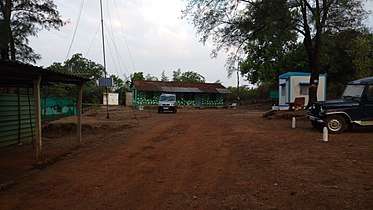 Dajipur gate complex
Dajipur gate complex Office at Dajipur gate
Office at Dajipur gate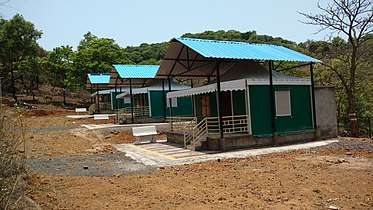 Tents at Dajipur village
Tents at Dajipur village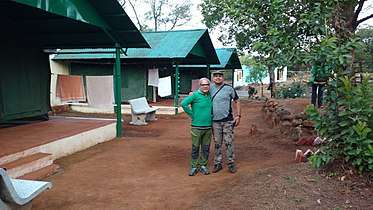 Tents at Dajipur forest gate
Tents at Dajipur forest gate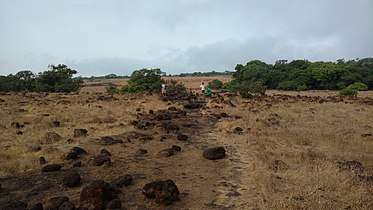 Shivrai sada
Shivrai sada
References
- "Western Ghats sub cluster, Sahyadri", World Heritage sites, Tentative lists, UNESCO, 2007, retrieved 1 March 2012
- Forests clearance
- "Radhanagari Wildlife Sanctuary", Protected areas, Maharashtra Forest Department, retrieved 1 March 2012
- "Radhanagari Wildlife Sanctuary", Eco-Informatics centre, Conservation database, ATREE, retrieved 2 March 2012
- Shri Padalkar V.V., Dr.Gatade D.G. (November 2011), "Tourist Attractions in Radhanagari Wildlife Sanctuary of Kolhapur District (Maharashtra)" (PDF), Variorum, Multi- Disciplinary e-Research Journal, A.S.C.College, Dept. Of History, 02, -II, retrieved 1 March 2012
- Mahaforest
| Wikimedia Commons has media related to Radhanagari Wildlife Sanctuary. |